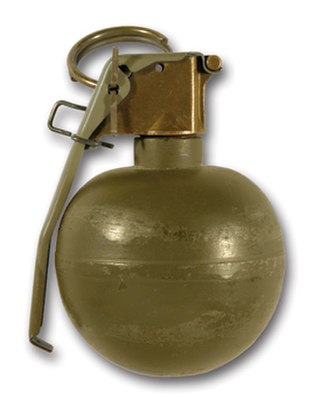
A grenade launcher is a weapon that fires a specially-designed large-caliber projectile, often with an explosive, smoke or gas warhead. Today, the term generally refers to a class of dedicated firearms firing unitary grenade cartridges. The most common type are man-portable, shoulder-fired weapons issued to individuals, although larger crew-served launchers are issued at higher levels of organisation by military forces.

"Mills bomb" is the popular name for a series of British hand grenades. They were the first modern fragmentation grenades used by the British Army and saw widespread use in the First and Second World Wars.

The Stielhandgranate was a German hand grenade of unique design. It was the standard issue of the German Empire during World War I, and became the widespread issue of Nazi Germany's Wehrmacht during World War II. The very distinctive appearance led to it being called a "stick grenade", or "potato masher" in British Army slang, and is today one of the most easily recognized infantry weapons of the 20th century.
A rifle grenade is a grenade that uses a rifle-based launcher to permit a longer effective range than would be possible if the grenade were thrown by hand.

The Grenade, Rifle No. 68 / Anti-Tank was a British anti-tank rifle grenade used during the Second World War and was one of the first operational weapons to utilise the shaped charge principle.

The Grenade, Hand, No. 1 was the first British hand grenade used in World War I. It was designed in the Royal Laboratory, based on reports and samples of Japanese hand grenades during the Russo-Japanese War provided by General Sir Aylmer Haldane, who was a British observer of that war.

The Mk 2 grenade is a fragmentation type anti-personnel hand grenade introduced by the U.S. armed forces in 1918. It was the standard issue anti-personnel grenade used during World War II, and also saw limited service in later conflicts, including the Korean War and Vietnam War. Replacing the failed Mk 1 grenade of 1917, it was standardized in 1920 as the Mk II, and redesignated the Mk 2 on April 2, 1945.

The Type 89 Grenade Discharger, inaccurately and colloquially known as a knee mortar by Allied forces, is a Japanese grenade launcher or light mortar that was widely used in the Pacific Ocean theatre of World War II. It got the nickname the "knee mortar" because of an erroneous Allied belief that these launchers could be fired by propping its plate against the leg. However, anyone trying to fire it this way would receive a severe bruise from its hefty recoil.
The military of the United States has used many of different types of hand grenades since its foundation. Presented on this page is a basic overview.

The MK3 offensive hand grenade is a cylindrical concussion grenade designed to produce casualties during close combat while minimizing danger to friendly personnel exposed in the open owing to minimal fragmentation. There is a secondary fragmentation hazard though from rocks, gravel, wood splinters, glass, etc. The grenade is also used for concussion effects in enclosed areas, for blasting, or for demolition tasks. The shock waves (overpressure) produced by this grenade when used in enclosed areas are greater than those produced by the fragmentation grenade. It is, therefore, very effective against enemy soldiers located in bunkers, buildings, and fortified areas. It is commonly known as the "concussion" or "demo" grenade.
In military munitions, a fuze is the part of the device that initiates function. In some applications, such as torpedoes, a fuze may be identified by function as the exploder. The relative complexity of even the earliest fuze designs can be seen in cutaway diagrams.

A grenade is an explosive weapon typically thrown by hand, but can also refer to an shell shot out by a rifles or a grenade launcher. A modern hand grenade generally consists of an explosive charge ("filler"), a detonator mechanism, an internal striker to trigger the detonator, and a safety lever secured by a linchpin. The user pulls the safety pin before throwing, and once thrown the safety lever gets released, allowing the striker to trigger a primer that ignites a fuze, which burns down to the detonator and explodes the main charge.
The No. 15 ball grenade was a grenade used by the British during World War I.
The No. 6 Grenade was a hand grenade used by the United Kingdom during World War I.
The No. 2 grenade is a percussion cap fragmentation and rifle grenade used by the United Kingdom during World War I.

The M17 is a rifle grenade that was used by the United States during World War II.

The M31 HEAT is a fin-stabilized anti-tank rifle grenade designed in the late 1950s to replace the Belgian ENERGA rifle grenade which was adopted by the US Army and US Marines as an emergency stop-gap measure during the Korean War. Like the ENERGA, it has a nose-initiated, based-detonated HEAT warhead, but unlike the ENERGA, the mechanical impact fuse system is replaced with a less complex and more reliable piezo-electric fuse system which also allows higher angles of impact, up to 65 degrees.

The Sprengpatrone or "explosive cartridge" in English was a rifle grenade that was developed by Germany and used by the Wehrmacht during World War II. The Sprengpatrone was designed to be fired from a Kampfpistole flare gun.












